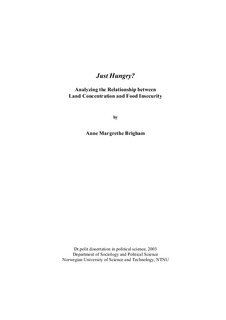| dc.description.abstract | Chronic hunger is among the most serious problems in the developing world today. When we consider hunger’s devastating effect on the health, welfare, and future prospects of the nearly 200 million children (or approximately 800 million people) that are chronically hungry, we realize that something has to be done.
Another serious problem concerns vast inequalities in access to agricultural land—a very important source of income and wealth in the developing world. Thus, after more than a decade in hibernation, land reform is back on the agenda in many developing countries. In the name of justice and rural poverty reduction, countries like Zimbabwe, Brazil, and South Africa hope to give the rural poor better access to agricultural land.
This dissertation investigates the potential for land reform as a means to reduce hunger in developing countries. Towards this end, it studies the relationship between land concentration and chronic hunger in the total population of 41 countries across the developing world. The study aims to establish whether countries with a more egalitarian distribution of land enjoy less hunger than countries where land is concentrated in the hands of the few. If this is the case, land reform could act as a means for reducing hunger.
I rely on an entitlement approach to the study of food insecurity, but see food availability as an integrated part of entitlement relations, mainly because of its effect on food prices. In particular, I devise a conceptual scheme over the complex relationship between land concentration and food insecurity among peasants, landless agricultural workers and industrial workers. This conceptual scheme builds on a dual economy perspective, and looks at the divergent effects of land concentration on the agricultural and the industrial sectors of the economy. A simplified model of this conceptual scheme is tested on the sample by way of multivariate regression analyses.
The most important finding of the study is that the effect of land concentration on food insecurity depends on the share of the population that relies on agriculture for a living, as well as the level of food availability in the country. These variables interact to produce very high levels of food insecurity in countries where there is a high level of land concentration, where a large share of the population depends on agriculture for a living, and where there is a low level of food availability. On the other hand, I find very low levels of food insecurity in countries with a high level of land concentration, where a low share of the total population depends on agriculture for a living, and where there is a high level of food availability. For this reason, I find both the highest and the lowest levels of food insecurity where land is concentrated in the hands of the few.
Another important finding of this study is that national food availability is much more important in relation to food insecurity than is usually assumed to be the case. For this reason the issue of food availability should be integrated more closely into the entitlement approach.
The dissertation (cautiously) concludes that very few countries are able to reduce their level of chronic hunger by implementing land reform. For most countries, land reform will most likely lead to more hunger. Moreover, by implementing land reform, countries (where land reform may help reduce food insecurity) may find themselves trapped in a situation with a medium level of food insecurity, from which it will be very hard to escape. This trap is a consequence of the low levels of agricultural labor productivity (and agricultural surplus available for industrialization) associated with a low level of land concentration. | nb_NO |
